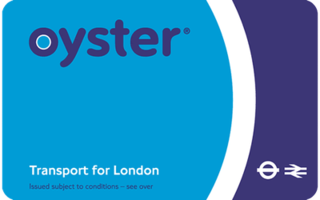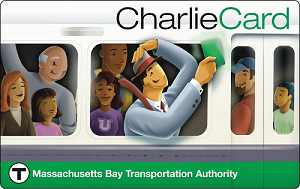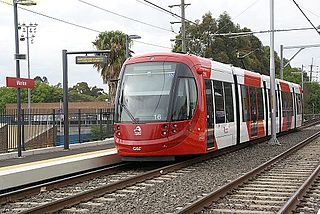
The Oyster card is a payment method for public transport in London, England, United Kingdom. A standard Oyster card is a blue credit-card-sized stored-value contactless smart card. It is promoted by Transport for London (TfL) and can be used on as part of London's integrated transport network on travel modes including London Buses, London Underground, the Docklands Light Railway (DLR), London Overground, Tramlink, some river boat services, and most National Rail services within the London fare zones. Since its introduction in June 2003, more than 86 million cards have been used.

The Sydney light rail network is a light rail/tram system serving the city of Sydney, New South Wales, Australia. The network currently consists of three passenger routes, the L1 Dulwich Hill, L2 Randwick and L3 Kingsford lines. The network comprises 42 stops and a system length of 24.7 km (15.3 mi), making it the second largest light rail network in Australia behind the tram network in Melbourne, Victoria. A fourth line, the 12 km (7.5 mi) L4 Westmead & Carlingford Line in Sydney's west, is planned to open in late 2024.

The CharlieCard is a contactless smart card used for fare payment for transportation in the Boston area. It is the primary payment method for the Massachusetts Bay Transportation Authority (MBTA) and several regional public transport systems in the U.S. state of Massachusetts. It is used on the MBTA's subway and bus services, but is not currently accepted on the MBTA Commuter Rail and ferries.

The State Transit Authority of New South Wales, also referred to as State Transit, was an agency of the Government of New South Wales operating bus services in Sydney. Superseding the Urban Transit Authority in 1989, it was also responsible for the provision of ferry services in Sydney until 2004 and bus and ferry services in Newcastle until 2017. It ceased trading after 2 April 2022 with its remaining operations to be contracted out by Transport for NSW to replacement operators. The New South Wales Government has not yet put forward a bill for the dissolution of the State Transit Authority of NSW.

Sydney Ferries is the public transport ferry network serving the city of Sydney, New South Wales. Services operate on Sydney Harbour and the connecting Parramatta River. The network is controlled by the New South Wales Government's transport authority, Transport for NSW, and is part of the authority's Opal ticketing system. In 2017–18, 15.3 million passenger journeys were made on the network.

Transport in Sydney is provided by an extensive network of public transport operating modes including metro, train, bus, ferry and light rail, as well as an expansive network of roadways, cycleways and airports. According to the 2006 census, in terms of travel to work or study Sydney has the highest rate of public transport usage among the Australian capital cities of 26.3% with more than 80% of weekday trips to/from Central Sydney being made by public transport. According to the New South Wales State Plan, the state has Australia's largest public transport system. The public transport network is regulated by Transport for NSW.

Buses account for close to six per cent of trips each day in the city of Sydney, New South Wales, Australia, forming a key part of the city's public transport system. The network initially evolved from a privately operated system of feeder services to railway stations in the outer suburbs, and a publicly operated network of bus services introduced to replace trams in the inner suburbs. The bus network has undergone major reforms since the 2000s–2010s, with the New South Wales Government taking responsibility for route and fare-setting, opening contracts for most routes up to competitive tendering, and introducing more cross-suburban services.

Newcastle Buses & Ferries was a commuter bus and ferry service operating in Newcastle and Lake Macquarie from 1935 until 2017. Part of the State Transit Authority, it operated 26 bus routes and the Stockton ferry across the Hunter River.
Public transport ticketing in New South Wales, Australia operated using magnetic-stripe technology between 1989 and 2016. This ticketing system, known variously as the Automated fare collection system, STATS and, from 2010, MyZone, was progressively replaced by a contactless smart card called Opal between 2012 and 2016.
The go card is an electronic smartcard ticketing system developed by Cubic Corporation, which is currently used on the Translink public transport network in South East Queensland, Australia. To use the go card, users hold the card less than 10 cm away from the reader to "touch on" before starting a journey, and must do the same to "touch off" the service at the end of the journey. The cost of each journey is deducted from the go card balance.

The Transit Access Pass (TAP) is a contactless smart card used for automated fare collection on most public transport agencies within Los Angeles County, California. The card is also available in electronic form, free of charge, in Apple Wallet, thereby bypassing the need to purchase the plastic USD $2 card. It is administered by the Los Angeles County Metropolitan Transportation Authority (Metro), and the card and fare collection systems are manufactured by Cubic Transportation Systems.

The AT HOP card is an electronic fare payment card that was released in two versions on Auckland public transport services, beginning in May 2011. The smart card roll out was the first phase in the introduction of an integrated ticketing and fares system that was rolled out across the region.

MetroCARD is a contactless smartcard ticketing system for public transport services in the Adelaide city and suburbs in South Australia. The system is managed by Adelaide Metro and is usable on their bus, train and tram services.

NSW TrainLink is a train and coach operator in Australia, providing services throughout New South Wales and the Australian Capital Territory, along with limited interstate services into Victoria, Queensland and South Australia. Its primary intercity and regional services are spread throughout five major rail lines, operating out of Sydney's Central railway station.

Sydney Trains is the operator of the suburban rail network serving the Greater Sydney metropolitan area in New South Wales, Australia. The network is a hybrid urban-suburban rail system with a central underground core that covers 369 km (229 mi) of route length over 813 km (505 mi) of track, with 170 stations on eight lines.

The Inner West Light Rail is a 12.8-kilometre (8.0 mi) light rail line in Sydney, New South Wales, Australia, running from Central railway station through the Inner West to Dulwich Hill and serving 23 stops. It was the original line of the Sydney light rail network. Services on the line are branded as the L1 Dulwich Hill Line since 2014.
The Opal card rolled out across New South Wales public transport services from 7 December 2012 until December 2014. Additionally, from December 2017, OpalPay was introduced and can be used as payment on selected third party services. This article contains all the dates of official Opal card and OpalPay rollouts.

Newcastle Transport is a public transport operator in Newcastle, New South Wales. A subsidiary of Keolis Downer, it operates bus, ferry and light rail services under contract to Transport for NSW.
The 2010s saw many developments relating to transport in the Australian city of Sydney. The decade saw a substantial investment in infrastructure, including a new airport, motorway projects, light rail lines, Australia's first metro system, the new Waratah fleet and the demise of the non-air conditioned S sets from the rail network. Planning and branding of public transport services became substantially more centralised.
OMNY is a contactless fare payment system, currently being implemented for use on public transit in the New York metropolitan area. OMNY can currently be used to pay fares at all New York City Subway and Staten Island Railway stations, on all MTA buses, AirTrain JFK, Metro North's Hudson Rail Link, and on the Roosevelt Island Tram; when completely rolled out, it will also replace the MetroCard on Bee-Line buses, and NICE buses. OMNY will also expand beyond the current scope of the MetroCard to include the Long Island Rail Road and Metro-North Railroad.























